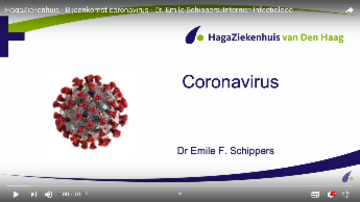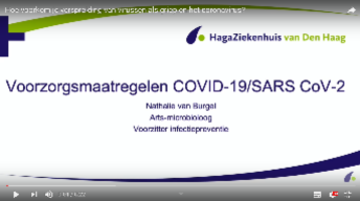Virulentie op oppervlaktes
LET OP:
Sinds 30 november 2021 worden de COVID-pagina's op deze website niet meer bijgehouden.
De contactgroep COVID is opgeheven en ondergebracht bij de contactgroep Biologische Factoren.
Actueel
- (toegevoegd 6-9-2021) Cherrie et al, 2021. Contamination of Air and Surfaces in Workplaces with SARS-CoV-2 Virus: A Systematic Review. Annals of Work Exposures and Health, 2021, 1–14
- (toegevoegd 12-9-2020) Airborne SARS-CoV-2 Is Rapidly Inactivated by Simulated Sunlight https://academic.oup.com/jid/article/222/4/564/5856149
- Simulated sunlight and matrix significantly affected decay rate of the virus. Mean decay rates (± SD) in simulated saliva, under simulated sunlight levels representative of late winter/early fall and summer were 0.121 ± 0.017 min−1 (90% loss, 19 minutes) and 0.306 ± 0.097 min−1 (90% loss, 8 minutes), respectively. Mean decay rate without simulated sunlight across all relative humidity levels was 0.008 ± 0.011 min−1 (90% loss, 286 minutes).
- (toegevoegd 12-9- 2020) Stability of SARS‐CoV‐2 and other coronaviruses in the environment and on common touch surfaces and the influence of climatic conditions: A review https://onlinelibrary.wiley.com/doi/full/10.1111/tbed.13707. The preventive measures depend mainly on the understanding of the transmission routes of this virus, its environmental stability, and its persistence on common touch surfaces. In this review, we present the available data on the stability of coronaviruses (CoVs), including SARS‐CoV‐2, from previous reports to help understand its environmental survival.
- Aerosol and Surface Stability of SARS-CoV-2 as Compared with SARS-CoV-1. Van Doremalen et al., 16 April 2020, N Engl J Med 2020; 382:1564-1567
https://www.nejm.org/doi/full/10.1056/NEJMc2004973 en het supplement https://www.nejm.org/doi/suppl/10.1056/NEJMc2004973/suppl_file/nejmc2004973_appendix.pdf. In aerosol, the virus can survive up to 10 hours, half-life in aerosol in this experiment was calculated at approximately 1 hour. It is virulent on copper 4 hours, on cardboard 24 hours, on plastic and stainless steel 3 days. The humidity in the aerosol experiment was 65% and the temperature 21-23 °C. The humidity in the surface experiments was 40%. It has not been described how the virus behaves at other temperatures and humidity. - Persistence of coronaviruses on inanimate surfaces and their inactivation with biocidal agents. G. Kampf et al., Journal of Hospital Infection, Volume 104, Issue 3, March 2020, Pages 246-251 https://reader.elsevier.com/reader/sd/pii/S0195670120300463. Coronaviruses can remain virulent on metal, glass or plastic for up to 9 days. Efficient disinfection procedures are also described.
- First data on stability and resistance of SARS coronavirus compiled by members of WHO laboratory network https://www.who.int/csr/sars/survival_2003_05_04/en/
- (toegevoegd 14-4-2020) Persistence of coronaviruses on inanimate surfaces and their inactivation with biocidal agents https://www.journalofhospitalinfection.com/article/S0195-6701(20)30046-3/fulltext 6 Febr 2020
- (toegevoegd 14-4-2020) Belgian Biosafety Server: Richtlijn biologische veiligheid voor diagnostiek en onderzoek inzake het nieuwe coronavirus (SARS-CoV-2) https://www.bioveiligheid.be/bioveiligheid-sars-cov-2
(gebaseerd op bovenstaande bronnen: Van Doremalen et al., 2020; WHO; Kampf et al., 2020).
Colleges
- Virologie en coronavirussen - dr. Raoul de Groot, Biomolecular Health Sciences afdeling Virologie. 10 maart 2020, Univ. Utrecht, https://lecturenet.uu.nl/Site1/Play/b3d2982d00c24747990bc20c37e30dc01d

- HagaZiekenhuis - Bijeenkomst coronavirus - Dr. Emile Schippers, Internist-Infectioloog 9 mrt. 2020 https://youtu.be/c94ZIW7I3Hs

- HAGAZiekenhuis Hoe voorkom je verspreiding van virussen als griep en het coronavirus? 9 mrt. 2020 https://www.youtube.com/watch?v=v5f67_WUEUk
- (toegevoegd 8-5-2020) Severe acute respiratory syndrome-related coronavirus: The species and its viruses – a statement of the Coronavirus Study Group https://www.biorxiv.org/content/10.1101/2020.02.07.937862v1.full.pdf
